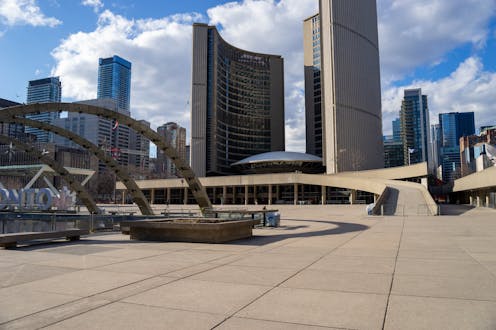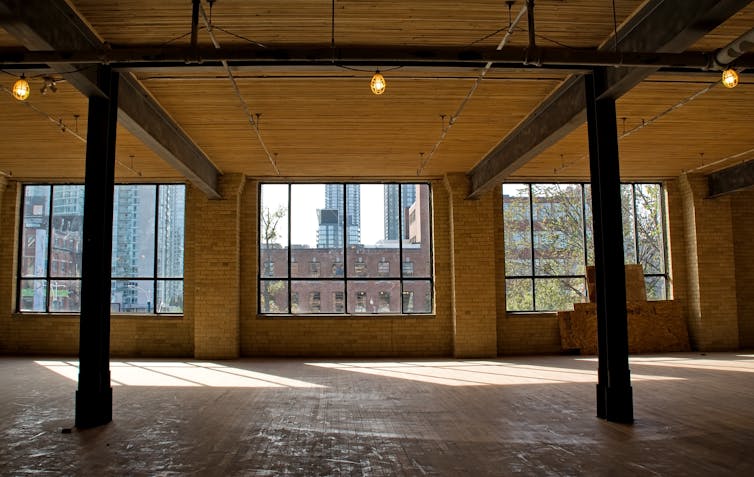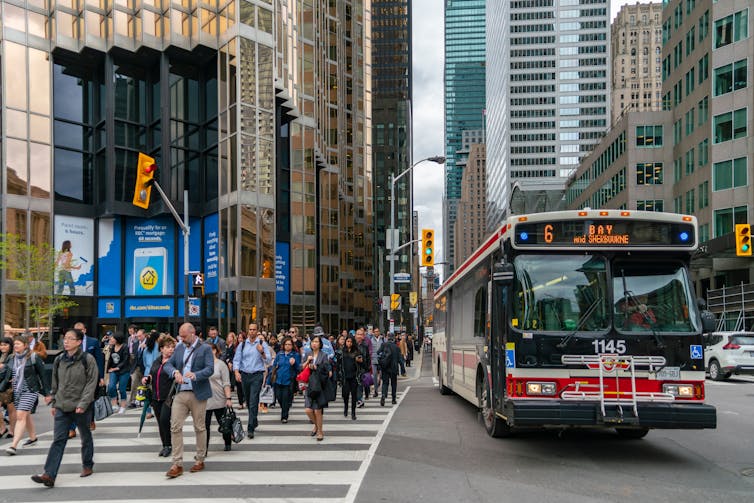Source: The Conversation (Au and NZ) – By Shauna Brail, Associate Professor, Institute for Management & Innovation, University of Toronto

Downtown Toronto, the core of Canada’s largest city, continues to reel from the lingering aftereffects of the pandemic. Yet after more than four years of pandemic-related challenges and reverberating consequences, we still do not have an answer to the question: How should the city move forward?
The concentration of offices, jobs and people in downtown Toronto benefits more than the city: Toronto’s economy anchors the regional economy. If Toronto falters, the region does too.
If leaders wait too much longer to address the myriad impacts of hybrid work on the city’s downtown office core, the city and region’s future is at risk. Toronto must change its ways or suffer economic, physical and social repercussions.
A transformative shift
In our recent report, “Remote Work: Urban Panacea or Curse?,” prepared for the Intergovernmental Committee on Economy and Labour Force Development, we identify the challenges faced by Toronto’s downtown resulting from a shift to hybrid work. We also highlight features that suggest Toronto’s future is not clear.
Public health measures during COVID-19 led to a transformative shift to hybrid work patterns for office-based workers, reducing office activity in the downtown. As measured by the Strategic Regional Research Alliance, Toronto’s office activity was only 12 per cent of pre-pandemic levels in March 2022, creeping up to 43 per cent one year later and reaching 63 per cent in March 2024, still well below pre-pandemic levels. Available office vacancy rates are over 10 per cent.
Public transit ridership remains low, with the TTC acknowledging that on Mondays and Fridays, commuters simply have not returned.
There is an oft-repeated narrative suggesting that Class A buildings — the most amenity-rich, well-located and high-quality buildings — are doing fine. Yet, a closer look at available vacancy rates suggests that Class A space is not significantly better off than Class B and C spaces in downtown Toronto.

(Shutterstock)
There is also a disconnect between measurements of foot traffic and available vacancy. Reduced foot traffic, used as a measure of activity in North American cities, highlights weakened activity in office-intensive areas. This reflects the current prominence of hybrid work in downtown office districts.
While vacancy rates are high, they do not match declines in footfall. In part, this is because of the time lag between long-term office leases and the shift to hybrid work.
Repurposing office space
Downtown office buildings represent an important source of property tax revenue to fund the city’s physical and social infrastructure and services. And they generate reliable long-term dividends for investors through real estate investment trusts (REITS).
But as office leases come up for renewal, employers are questioning whether to downsize their space, and REITS are beginning to report losses. What will become of empty office spaces: will new businesses fill them, or should they be repurposed?
Hybrid work creates an opportunity for Toronto to adapt some downtown office spaces to other uses. Given Toronto’s housing affordability crisis, the potential to repurpose select office buildings for housing is desirable. Other downtown land uses would be welcome too, to create a downtown filled with amenities, employment opportunities and attractions for residents, visitors, workers and more.
This aligns with ideas around the value of 15-minute cities, strategies that have seen success in cities like London, Paris and New York.
Read more:
15-minute cities: how to separate the reality from the conspiracy theory
The return of downtown?
Before we abandon the notion of downtown as a place of office work, we need to take care, because here’s what the data also shows: office activity continues to increase, transit ridership continues to recover, and the total number of jobs in the downtown core is rising.

(Shutterstock)
Furthermore, data confirms that Toronto employment opportunities follow the same patterns as other large cities. Based on our analysis of data from Vicinity Jobs, a Canadian employment data company, the availability of remote and hybrid job opportunities is higher in Toronto than other places in Ontario.
This is particularly the case when comparing Toronto with surrounding municipalities — the concentration of hybrid work in Toronto risks hollowing out the city and the region. Avoiding this urban doom loop means diversifying spaces and activities in downtown Toronto, including through creating more affordable housing.
Toronto is a city that has taken small steps to successfully address big problems in the past. Today’s challenges demand ambitious actions.
![]()
Shauna Brail receives funding from the Social Sciences and Humanities Research Council.
Tara Vinodrai receives funding from the Social Sciences and Humanities Research Council of Canada. She is a member of the Association of Collegiate Schools of Planning and the Economic Developers Council of Ontario.
– ref. Revitalizing Toronto’s downtown core after COVID-19 greatly benefits the city and the region – https://theconversation.com/revitalizing-torontos-downtown-core-after-covid-19-greatly-benefits-the-city-and-the-region-228653








